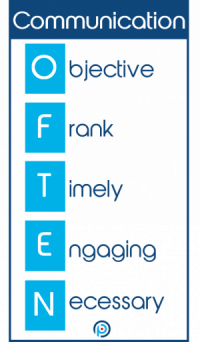
Description
Communicate OFTEN
Effective communication results in minimising potential misunderstanding, creates unity as everyone is aligned or clear on the views or aims of another individual or company. An effective communicator understands their audience, chooses an appropriate communication channel, hones their message to this channel and encodes the message to reduce misunderstanding by the receiver(s). Overall, this results in improved employee and business relationships. There are of course many styles and types of communication, for example verbal. When done face to face, other communication factors come into play such as eye contact (or lack of), tone of voice and body language. This is the same virtually or in person. Written communication is an excellent way to reinforce messaging, but it should not be assumed it is understood. All too often written communication can be misinterpreted or simply not read. Choosing the type of communication method is equally as important as what the communication is. We recommend that communication happens OFTEN.- Being OBJECTIVE allows the communicator to be constructive in their communication and think about the audience(s) and what is important for them to hear or take from the communication.
- Being FRANK also means there are no hidden agendas and therefore builds trust between parties and creates a more effective relationship.
- Communication should also be TIMELY. For example, if feedback is given at the time, or shortly after someone’s actions, this has a much more positive impact as it is given in context, is relevant and likely more accurate.
- Being ENGAGING whilst communicating is vital as this ensures the receiver is focused and possibly inspired by the message.
- Communication should also only be done when NECESSARY. Avoid unnecessary communication, ask yourself, is this relevant to this audience? Will it make a difference or impact their day job?
Info
-->





